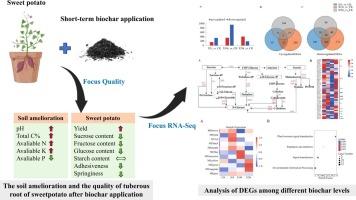当前位置:
X-MOL 学术
›
Ind. Crops Prod.
›
论文详情
Our official English website, www.x-mol.net, welcomes your
feedback! (Note: you will need to create a separate account there.)
Transcriptome analysis reveals the impact of short-term biochar application on starch and sucrose metabolism in sweet potato tuberous roots
Industrial Crops and Products ( IF 5.6 ) Pub Date : 2024-11-17 , DOI: 10.1016/j.indcrop.2024.120050 Jingzhen Zhang, Ximing Xu, Taojun Li, Zunfu Lv, Yueming Zhu, Jing Li, Guoquan Lu
Industrial Crops and Products ( IF 5.6 ) Pub Date : 2024-11-17 , DOI: 10.1016/j.indcrop.2024.120050 Jingzhen Zhang, Ximing Xu, Taojun Li, Zunfu Lv, Yueming Zhu, Jing Li, Guoquan Lu

|
Biochar has been proven to be an effective method for enhancing sweet potato yield. However, limited research has been conducted on the molecular and physiological mechanisms underlying biochar's regulation of starch biosynthesis. This study aimed to investigate the transcriptome sequencing, which revealed the effects of short-term biochar application (STBA) on tuberous roots of sweet potato and the. We designed four STBA treatments: 0 t·hm−2 (CK), 5 t·hm−2 (X5t), 10 t·hm−2(X10t), and 20 t·hm−2(X20t), through a comprehensive analysis encompassing physiological data and RNA-seq analysis. The investigation included a comprehensive analysis integrating physiological measurements with RNA-seq data to elucidate the underlying mechanisms. The results showed that STBA enhanced the availability of nitrogen and potassium significantly, while also elevating the soil's pH levels. The 20 t·hm−2 STBA substantially enhanced sweet potato yields by 72.21 %, and the starch content of all STBA was not significantly different with CK. STBA decreased the sucrose, starch, glucose, and fructose content of tuberous root by 3–12 %, 1–5 %, 5–8 %, and 5–16 %. DEGs analysis identified distinct gene regulation patterns following biochar treatments, with the 5–10 t·hm−2 dosages predominantly down-regulating genes, including those in starch and sucrose metabolism pathways. WGCNA analysis uncovered 11 modules, highlighting biochar's influence on hormone signal transduction pathways, which was validated through qRT-PCR of five key genes. The study's findings light on the impact of STBA on the starch quality of sweet potatoes and inform biochar application strategies in agriculture.
中文翻译:

转录组分析揭示了短期生物炭施用对甘薯块根淀粉和蔗糖代谢的影响
生物炭已被证明是提高甘薯产量的有效方法。然而,对生物炭调节淀粉生物合成的分子和生理机制的研究有限。本研究旨在调查转录组测序,揭示了短期生物炭应用 (STBA) 对甘薯块根的影响。我们设计了四种 STBA 处理:0 t·hm-2 (CK)、5 t·hm-2 (X5t)、10 t·hm-2 (X10t) 和 20 t·hm-2 (X20t),通过包括生理数据和 RNA-seq 分析的综合分析。该调查包括一项综合分析,将生理测量与 RNA-seq 数据相结合,以阐明潜在机制。结果表明,STBA 显着提高了氮和钾的可用性,同时还提高了土壤的 pH 值。20 t·hm−2 STBA 显著提高了甘薯产量 72.21 %,并且所有 STBA 的淀粉含量与 CK 无显著差异。STBA 使块茎根的蔗糖、淀粉、葡萄糖和果糖含量降低了 3–12 %、1–5 %、5–8 % 和 5–16 %。DEGs 分析确定了生物炭处理后不同的基因调控模式,其中 5-10 t·hm-2 剂量主要下调基因,包括淀粉和蔗糖代谢途径中的基因。WGCNA 分析发现了 11 个模块,突出了生物炭对激素信号转导途径的影响,并通过 5 个关键基因的 qRT-PCR 验证了这一点。该研究结果阐明了 STBA 对甘薯淀粉质量的影响,并为农业中的生物炭应用策略提供了信息。
更新日期:2024-11-17
中文翻译:

转录组分析揭示了短期生物炭施用对甘薯块根淀粉和蔗糖代谢的影响
生物炭已被证明是提高甘薯产量的有效方法。然而,对生物炭调节淀粉生物合成的分子和生理机制的研究有限。本研究旨在调查转录组测序,揭示了短期生物炭应用 (STBA) 对甘薯块根的影响。我们设计了四种 STBA 处理:0 t·hm-2 (CK)、5 t·hm-2 (X5t)、10 t·hm-2 (X10t) 和 20 t·hm-2 (X20t),通过包括生理数据和 RNA-seq 分析的综合分析。该调查包括一项综合分析,将生理测量与 RNA-seq 数据相结合,以阐明潜在机制。结果表明,STBA 显着提高了氮和钾的可用性,同时还提高了土壤的 pH 值。20 t·hm−2 STBA 显著提高了甘薯产量 72.21 %,并且所有 STBA 的淀粉含量与 CK 无显著差异。STBA 使块茎根的蔗糖、淀粉、葡萄糖和果糖含量降低了 3–12 %、1–5 %、5–8 % 和 5–16 %。DEGs 分析确定了生物炭处理后不同的基因调控模式,其中 5-10 t·hm-2 剂量主要下调基因,包括淀粉和蔗糖代谢途径中的基因。WGCNA 分析发现了 11 个模块,突出了生物炭对激素信号转导途径的影响,并通过 5 个关键基因的 qRT-PCR 验证了这一点。该研究结果阐明了 STBA 对甘薯淀粉质量的影响,并为农业中的生物炭应用策略提供了信息。


















































 京公网安备 11010802027423号
京公网安备 11010802027423号